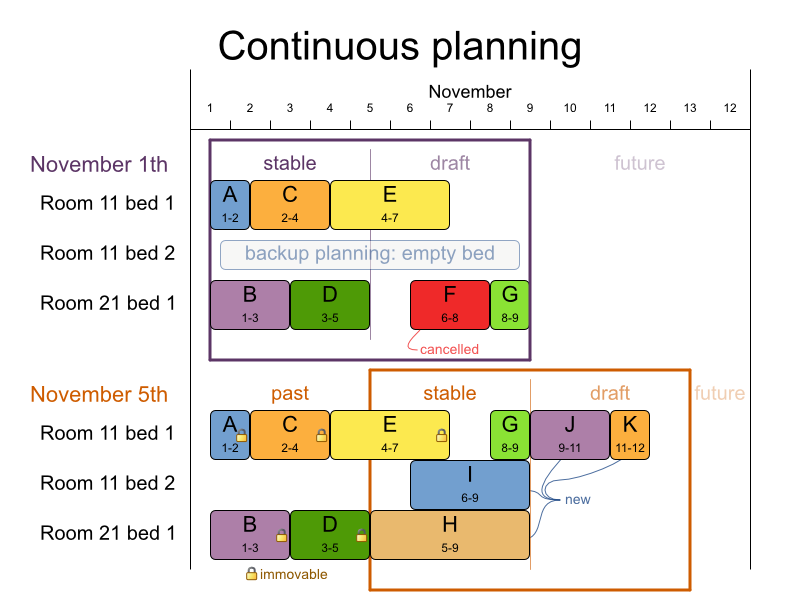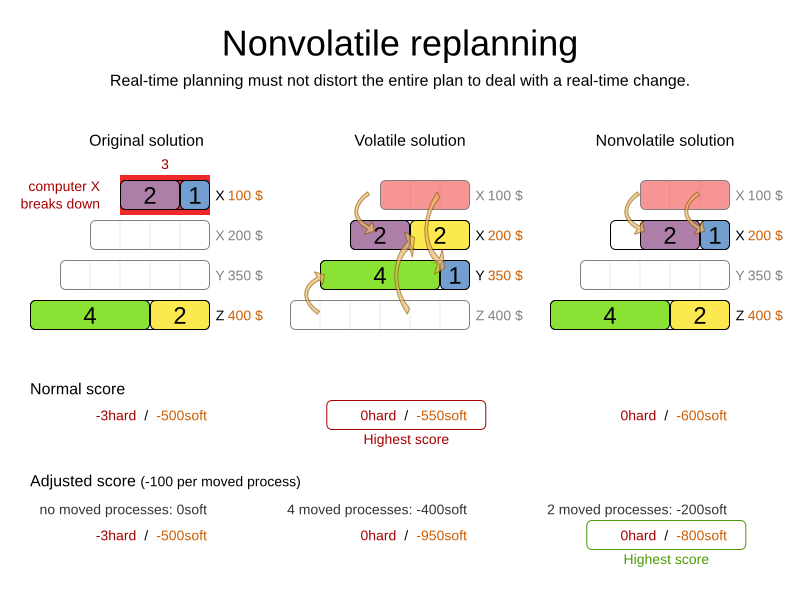Chapter 15. Repeated Planning
15.1. Introduction to Repeated Planning
The world constantly changes. The problem facts used to create a solution, might change before or during the execution of that solution. There are different situations (which can be combined):
- Unforeseen fact changes: For example: an employee assigned to a shift calls in sick, an airplane scheduled to take off has a technical delay, one of the machines or vehicles break down, … Use backup planning.
- Impossible to assign all entities now: Leave some unassigned. For example: there are 10 shifts at the same time to assign but only 9 employees to handle shifts. Use overconstrained planning.
- Unknown long term future facts: For example: the hospital admissions for the next 2 weeks are reliable, but those for week 3 and 4 are less reliable and for week 5 and beyond are not worth planning yet. Use continuous planning.
- Constantly changing problem facts: Use real-time planning.
Waiting to start planning—to lower the risk of problem facts changing—usually isn’t a good way to deal with that. More CPU time means a better planning solution. An incomplete plan is better than no plan.
Luckily, the optimization algorithms support planning a solution that’s already (partially) planned, known as repeated planning.
15.2. Backup Planning
Backup planning is the technique of adding extra score constraints to create space in the planning for when things go wrong. That creates a backup plan in the plan. For example: try to assign an employee as the spare employee (1 for every 10 shifts at the same time), keep 1 hospital bed open in each department, …
Then, when things go wrong (one of the employees calls in sick), change the problem facts on the original solution (delete the sick employee leave his/her shifts unassigned) and just restart the planning, starting from that solution, which has a different score now. The construction heuristics will fill in the newly created gaps (probably with the spare employee) and the metaheuristics will even improve it further.
15.3. Overconstrained Planning
When there is no feasible solution to assign all planning entities, it’s often desired to assign as many entities as possible without breaking hard constraints. This is called overconstrained planning.
To implement this:
- Add a additional score level (usually a medium level between the hard and soft level) by switching ScoreDefinition.
- Make the planning variable nullable.
- Add a score constraint on the new level (so usually a medium constraint) to penalize the number of unassigned entities (or a weighted sum of them).
15.4. Continuous Planning (Windowed Planning)
Continuous planning is the technique of planning one or more upcoming planning windows at the same time and repeating that process monthly, weekly, daily or hourly. Because time is infinite, there are infinite future windows, so planning all future windows is impossible. Instead, plan only a fixed number of upcoming planning windows.
Past planning windows are immutable. The first upcoming planning window is considered stable (unlikely to change), while later upcoming planning windows are considered draft (likely to change during the next planning effort). Distant future planning windows are not planned at all.
Past planning windows have only immovable planning entities: the planning entities can no longer be changed (they are unable to move), but some of them are still needed in the score calculation, as they might affect some of the score constraints that apply on the upcoming planning entities. For example: when an employee should not work more than 5 days in a row, he shouldn’t work today and tomorrow if he worked the past 4 days already.
Sometimes some planning entities are semi-immovable: they can be changed, but occur a certain score penalty if they differ from their original place. For example: avoid rescheduling hospital beds less than 2 days before the patient arrives (unless it’s really worth it), avoid changing the airplane gate during the 2 hours before boarding (unless there is no alternative), …
Notice the difference between the original planning of November 1th and the new planning of November 5th: some problem facts (F, H, I, J, K) changed, which results in unrelated planning entities (G) changing too.
15.4.1. Immovable Planning Entities
To make some planning entities immovable, simply add an entity SelectionFilter that returns true if an entity is movable and false if it is immovable.
And configure it like this:
@PlanningEntity(movableEntitySelectionFilter = MovableShiftAssignmentSelectionFilter.class)
public class ShiftAssignment {
...
}
@PlanningEntity(movableEntitySelectionFilter = MovableShiftAssignmentSelectionFilter.class)
public class ShiftAssignment {
...
}
Custom MoveListFactory and MoveIteratorFactory implementations must make sure that they don’t move immovable entities.
15.4.2. Nonvolatile Replanning to minimize disruption (Semi-movable Planning Entities)
Replanning an existing plan can be very disruptive on the plan. If the plan affects humans (such as employees, drivers, …), very disruptive changes are often undesirable. In such cases, nonvolatile replanning helps: the gain of changing a plan must be higher than the disruption it causes.
For example, in the Machine Reassignment example, the entity has both the planning variable machine and its original value originalMachine:
During planning, the planning variable machine changes. By comparing it with the originalMachine, a change in plan can be penalized:
The soft penalty of -1000 means that a better solution is only accepted if it improves the soft score for at least 1000 points per variable changed (or if it improves the hard score).
15.5. Real-time Planning
To do real-time planning, first combine backup planning and continuous planning with short planning windows to lower the burden of real-time planning. As time passes, the problem itself changes:
In the example above, 3 customers are added at different times (07:56, 08:02 and 08:45), after the original customer set finished solving at 07:55 and in some cases after the vehicles already left. Planner can handle such scenario’s with ProblemFactChange (in combination with immovable planning entities).
15.5.1. ProblemFactChange
While the Solver is solving, an outside event might want to change one of the problem facts, for example an airplane is delayed and needs the runway at a later time. Do not change the problem fact instances used by the Solver while it is solving (from another thread or even in the same thread), as that will corrupt it. Instead, add a ProblemFactChange to the Solver which it will execute in the solver thread as soon as possible.
public interface ProblemFactChange {
void doChange(ScoreDirector scoreDirector);
}
public interface ProblemFactChange {
void doChange(ScoreDirector scoreDirector);
}Here’s an example:
Any change on the problem facts or planning entities in a ProblemFactChange must be told to the ScoreDirector.
To write a ProblemFactChange correctly, it’s important to understand the behavior of a planning clone:
-
Any change in a
ProblemFactChangemust be done on theSolutioninstance ofscoreDirector.getWorkingSolution(). TheworkingSolutionis a planning clone of theBestSolutionChangedEvent'sbestSolution. So theworkingSolutionin theSolveris never the same instance as theSolutionin the rest of your application. -
A planning clone also clones the planning entities and planning entity collections. So any change on the planning entities must happen on the instances held by
scoreDirector.getWorkingSolution(). A planning clone does not clone the problem facts, nor the problem fact collections. Therefore the
workingSolutionand thebestSolutionshare the same problem fact instances and the same problem fact list instances.Any problem fact or problem fact list changed by a
ProblemFactChangemust be problem cloned first (which can imply rerouting references in other problem facts and planning entities). Otherwise, if theworkingSolutionandbestSolutionare used in different threads (for example a solver thread and a GUI event thread), a race condition can occur.
Many types of changes can leave a planning entity uninitialized, resulting in a partially initialized solution. That’s fine, as long as the first solver phase can handle it. All construction heuristics solver phases can handle that, so it’s recommended to configure such a solver phase as the first phase.
In essence, the Solver stops, runs the ProblemFactChange and restarts. This is a warm start because its initial solution is the adjusted best solution of the previous run. Each solver phase runs again. This implies the construction heuristic runs again, but because little or no planning variables are uninitialized (unless you have a nullable planning variable), it finishes much quicker than in a cold start.
Each configured Termination resets (both in solver and phase configuration), but a previous call to terminateEarly() is not undone. Normally however, you won’t configure any Termination (except in daemon mode), just call Solver.terminateEarly() when the results are needed. Alternatively, do configure a Termination and use the daemon mode in combination with BestSolutionChangedEvent as described below.
15.5.2. Daemon: solve() Does Not Return
In real-time planning, it’s often useful to have a solver thread wait when it runs out of work, and immediately resume solving a problem once new problem fact changes are added. Putting the Solver in daemon mode has these effects:
If the
Solver'sTerminationterminates, it does not return fromsolve()but blocks its thread instead (which frees up CPU power).-
Except for
terminateEarly(), which does make it return fromsolve(), freeing up system resources and allowing an application to shutdown gracefully. -
If a
Solverstarts with an empty planning entity collection, it waits in the blocked state immediately.
-
Except for
-
If a
ProblemFactChangeis added, it goes into the running state, applies theProblemFactChangeand runs theSolveragain.
To configure the daemon mode:
<solver> <daemon>true</daemon> ... </solver>
<solver>
<daemon>true</daemon>
...
</solver>
Don’t forget to call Solver.terminateEarly() when your application needs to shutdown to avoid killing the solver thread unnaturally.
Subscribe to the BestSolutionChangedEvent to process new best solutions found by the solver thread. A BestSolutionChangedEvent doesn’t guarantee that every ProblemFactChange has been processed already, nor that the solution is initialized and feasible. To ignore BestSolutionChangedEvents with such invalid solutions, do this:



